Related Research Articles

Chinese art is visual art that originated in or is practiced in China, Greater China or by Chinese artists. Art created by Chinese residing outside of China can also be considered a part of Chinese art when it is based on or draws on Chinese culture, heritage, and history. Early "Stone Age art" dates back to 10,000 BC, mostly consisting of simple pottery and sculptures. After that period, Chinese art, like Chinese history, was typically classified by the succession of ruling dynasties of Chinese emperors, most of which lasted several hundred years. The Palace Museum in Beijing and the National Palace Museum in Taipei contains extensive collections of Chinese art.

Ink wash painting ; is a type of Chinese ink brush painting which uses washes of black ink, such as that used in East Asian calligraphy, in different concentrations. It emerged during the Tang dynasty of China (618–907), and overturned earlier, more realistic techniques. It is typically monochrome, using only shades of black, with a great emphasis on virtuoso brushwork and conveying the perceived "spirit" or "essence" of a subject over direct imitation. Ink wash painting flourished from the Song dynasty in China (960–1279) onwards, as well as in Japan after it was introduced by Zen Buddhist monks in the 14th century. Some Western scholars divide Chinese painting into three periods: times of representation, times of expression, and historical Oriental art. Chinese scholars have their own views which may be different; they believe that contemporary Chinese ink wash paintings are the pluralistic continuation of multiple historical traditions.
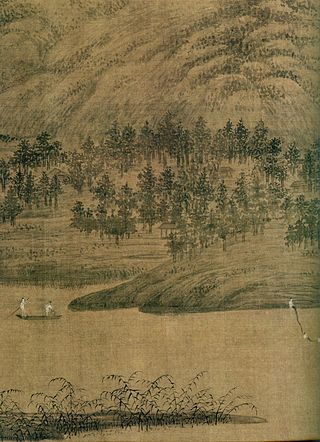
Dong Yuan was a Chinese painter.

Wang Xizhi was a Chinese calligrapher, politician and general from the Jin dynasty (266–420) known for his mastery of Chinese calligraphy. He is often regarded as the greatest calligrapher in Chinese history. His most famous work, composed in 353, is the Lantingji xu.
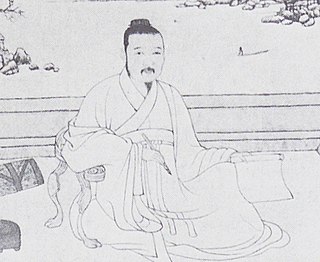
Ni Zan was a Chinese painter during the Yuan and early Ming periods. Along with Huang Gongwang, Wu Zhen, and Wang Meng, he is considered to be one of the Four Masters of the Yuan Dynasty.
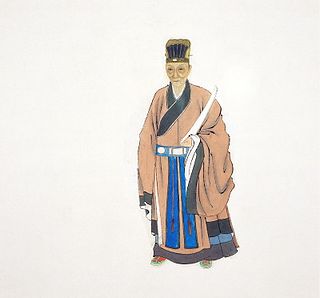
Dong Qichang, was a Chinese art theorist, calligrapher, painter, and politician of the later period of the Ming dynasty.

Kwang-chih Chang, commonly known as K. C. Chang, was a Taiwanese-American archaeologist and sinologist. He was the John E. Hudson Professor of archaeology at Harvard University, Vice-President of the Academia Sinica, and a curator at the Peabody Museum of Archaeology and Ethnology. He helped to bring modern, western methods of archaeology to the study of ancient Chinese history. He also introduced new discoveries in Chinese archaeology to western audiences by translating works from Chinese to English. He pioneered the study of Taiwanese archaeology, encouraged multi-disciplinal anthropological archaeological research, and urged archaeologists to conceive of East Asian prehistory as a pluralistic whole.
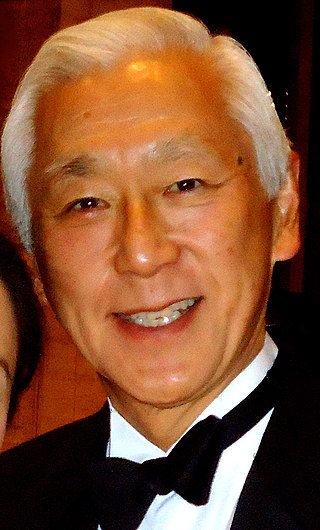
Oscar Liu-Chien Tang is a Chinese-born American businessman, financier, investor, and philanthropist. He is best known for being the co-founder of Reich & Tang, an asset management firm. Tang was elected a fellow of the American Academy of Arts and Sciences in 2005. Prior to this, he was appointed to the New York State Council on the Arts from 2000 to 2004 and the President's Committee on the Arts and Humanities from 1990 to 1993.
Jerome L. Silbergeld is an American scholar of Chinese art history. He has taught at Princeton University and the University of Washington.
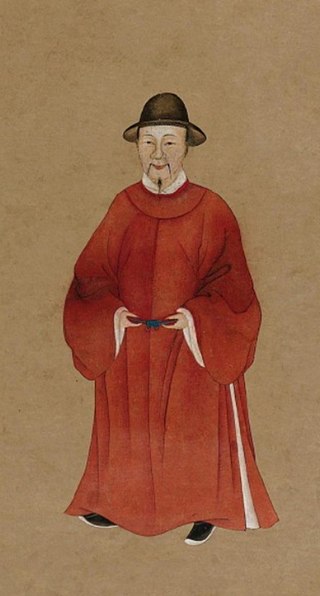
Tang Yin, courtesy name Bohu (伯虎) and Ziwei (子畏), was a Chinese painter, calligrapher, and poet of the Ming dynasty period.

The Princeton University Art Museum (PUAM) is the Princeton University gallery of art, located in Princeton, New Jersey. With a collecting history that began in 1755, the museum was formally established in 1882, and now houses over 113,000 works of art ranging from antiquity to the contemporary period. The Princeton University Art Museum dedicates itself to supporting and enhancing the university's goals of teaching, research, and service in fields of art and culture, as well as to serving regional communities and visitors from around the world. Its collections concentrate on the Mediterranean region, Western Europe, Asia, the United States, and Latin America.
Chi-Chien Wang, better known as C. C. Wang, was a Chinese-born artist and art collector based in New York City.
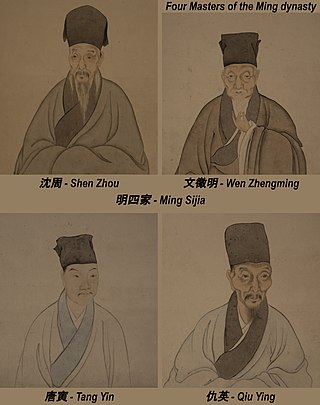
The Four Masters of the Ming dynasty are a traditional grouping in Chinese art history of four famous Chinese painters that lived during the Ming dynasty. The group consists of Shen Zhou (1427–1509), Wen Zhengming (1470–1559), Tang Yin (1470–1523), and Qiu Ying (c.1494–c.1552). They were contemporaries, with Shen being the teacher of Wen, while Tang and Qiu was taught by Zhou Chen (1460–1535). All five of the aforementioned painters were part of the Wu School. Their styles and subject matter were varied. Qiu was solely a painter, while the other three developed distinct styles of painting, calligraphy, and poetry.

The Admonitions Scroll is a Chinese narrative painting on silk that is traditionally ascribed to Gu Kaizhi, but which modern scholarship regards as a 5th to 8th century work that may or may not be a copy of an original Jin dynasty (266–420) court painting by Gu. The full title of the painting is Admonitions of the Court Instructress. It was painted to illustrate a poetic text written in 292 by the poet-official Zhang Hua (232–300). The text itself was composed to reprimand Empress Jia (257–300) and to provide advice to the women in the imperial court. The painting illustrates this text with scenes depicting anecdotes about exemplary behaviour of historical palace ladies, as well as with more general scenes showing aspects of life as a palace lady.
James Francis Cahill was an American art collector and historian who taught at the University of California, Berkeley. He was considered one of the world's top authorities on Chinese art.
I Lo-fen is a Taiwanese scholar and writer. She received her Chinese Literature Ph.D. from National Taiwan University. She has been an associate professor in the Division of Chinese in Nanyang Technological University’s School of Humanities and Social Sciences since July 2006, and was the Head of the Division (2014-2016). She had formerly committed in institutes like the National Taiwan University, Tamkang University, Fu Jen Catholic University, and the Institute of Chinese Literature and Philosophy at Academia Sinica. In addition, she was also a visiting professor at Stanford University in the United States and East Asian Institute at Sungkyunkwan University, South Korea. Her research expertise lies in Text and Image Studies, Su Shi studies, East Asian literature and intercultural exchanges in Classical Chinese, and Singapore literature, history, and arts studies. She is also a board member of the China Su Shi Studies Society, and an international board member of the Korea Society of East Asian Comparative Literature. She is the Founder and Chairman of the "Text and Image Studies Society"(文图学会) that was official registered in Singapore on 18 December 2017. By integrating the history of Chinese literature and arts, she has accomplished a series of researches on poems in paintings and poetic imagery. She then proposed the idea of the “Text and Image Studies”(文图学) and focused on the relations, comparison and intertextuality between poems and paintings. From there, she has established her literary theory in arts creation and culture of aesthetics. She is also a column writer of Singapore Lianhe Zaobao (2007-), and she hosts podcast "Lofen says".

Shih Shou-chien is a Taiwanese scholar, writer, and professor at National Taiwan University. He served as Director of National Palace Museum from May 2004 to January 2006. He is an academician of Academia Sinica.

"Night-Shining White" is a monochrome ink-on-paper painting by the Chinese artist Han Gan. It is an example of Tang dynasty painting, created in the middle of the 8th century. The work depicts a cavalry horse owned by the Emperor Xuanzong of the Tang dynasty, tethered to a post. It is considered one of the greatest equine portraits in Chinese painting. It was acquired by the Metropolitan Museum in 1977.

"One-Corner" or "Ma's One-Corner" (Chinese traditional: 馬一角; Chinese simplified: 马一角)is a particular type of composition in traditional Chinese painting. It was popular in the Southern Song dynasty Imperial Academy Painting, and the painters pushed the actual subjects of the painting to one corner and set them against the empty background suggestive of mist or snow. One good example is "Watching the Deer by a Pine Shaded Stream" in the Cleveland Museum of Art collection by the Southern Song dynasty master Ma Yuan 马远, after whom the term was named. Translating the term as "One-corner Ma" and considering it the nickname of Ma Yuan is not necessarily what the term originally meant in ancient China. Together with Xia Gui 夏圭, who was famous for "One-side" composition, Ma Yuan was a leader of the Ma-Xia school of painting.

"One-Side" or "Xia's One-Side", just like "One-Corner" or "Ma's One-Corner", is also a particular type of composition in traditional Chinese painting. In this composition, the painters pushed the actual subjects of the painting to one side of the painting and made the other side empty implying a background of mist or snow. An imitation of master Xia Gui's 夏圭 landscape painting, "Returning Home in a Driving Rain", clearly illustrates how the artist arranged all of the trees, houses, and rocks at the bottom side of the painting and set them against the top empty portion of the painting where mist and distant mountains were lightly depicted--the two read stamps were not a part of the original painting.
References
- 1 2 3 4 5 6 7 Xiao, Yongjun (肖永军) (October 4, 2018). 方闻先生辞世,半个世纪美国亚洲艺术史学界的开拓者与领航者. The Paper (in Chinese (China)). Retrieved October 5, 2018.
- 1 2 3 4 5 6 7 8 9 "Wen Fong". Princeton University. Retrieved October 5, 2018.
- 1 2 "Wen Fong, 'giant in the field of Chinese art history,' dies at 88". Princeton University. Retrieved October 23, 2018.
- 1 2 3 Bowley, Graham (February 18, 2014). "James Cahill, Influential Authority on Chinese Art, Dies at 87". The New York Times. Retrieved October 4, 2018.
- ↑ Dobrzynski, Judith H. (May 25, 1997). "Landscapes Were Never The Same". New York Times. Retrieved October 21, 2018.
- ↑ Cahill, James. "73. Respecting China". Jamescahill.info. Retrieved October 21, 2018.
- ↑ Cahill, James (2006). "CLP 155: 2006 "Wen Fong and Me." Symposium honoring Wen Fong Princeton". Jamescahill.info. Retrieved October 5, 2018.
- ↑ "Academician Wen Fong Has Passed Away". Academia Sinica. October 11, 2018. Retrieved October 23, 2018.
- ↑ "APS Member History". search.amphilsoc.org. Retrieved March 28, 2022.